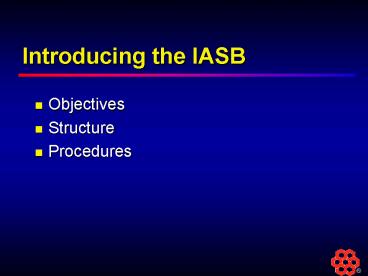Introducing the IASB - PowerPoint PPT Presentation
1 / 25
Title:
Introducing the IASB
Description:
Independent. Partnership with national standard setters ... IAS required in consolidated financial statements of publicly-traded companies by 2005 ... – PowerPoint PPT presentation
Number of Views:79
Avg rating:3.0/5.0
Title: Introducing the IASB
1
Introducing the IASB
- Objectives
- Structure
- Procedures
2
IASB A Refocused Objective
- Development of a single set of high quality,
understandable and enforceable global accounting
standards that require high quality, transparent
and comparable information in financial
statements - Bringing about convergence of national accounting
standards and International Accounting Standards
3
IASBs Organisation
Trustees (19)
Standards Advisory Council
Board (14)
Steering Committees Other Advisors
SIC
Staff
4
The IASB Members
- Sir David Tweedie Chair
- Liaison Responsibilities
- Australia/New Zealand, Canada, France, Germany,
Japan, UK and USA - Others
- Public practice (1) Preparers (2) Users (2)
Academic (1)
5
Standards Advisory Council
- Appointed by the Trustees
- Broad-based constituents
- Advises the Board and/or the Trustees
- Appointments announced in June 2001
6
SAC - Distribution
7
IASB Interpretations
- Standing Interpretations Committee
- Appointed by the Trustees
- Reports to the Board
- IASB has requested that SIC review its role and
make suggestions for improvements to mandate and
operating procedures
8
IASB Due Process
- Board, SAC and SIC meet in public
- IASB will solicit comments via
- Discussion Documents
- Exposure Drafts
- Draft SIC Interpretations
- Public hearings
9
IASB Achieving Convergence
- IASB is to bring about convergence of national
accounting standards and IAS - Formal liaison with national standard setters
- Sharing technical staff and resources
- Coordinating agendas and due process
- Regular meetings between IASB and national chairs
10
IASB Fundamentals for Success
- IASB is a global standard setter
- Independent
- Partnership with national standard setters
- Not dominated by any regional or professional
interest - Accessible
11
IASB Work Programme 2001
- IASB Agenda likely to feature
- Improvements project
- Transition to IAS as a primary basis
- Fundamental projects
- Leadership projects
- Convergence projects
12
IASB Agenda Priority Projects
- Business combinations
- Financial instruments - derecognition
- Consolidation policy
- Insurance contracts
- Measurement and impairment
- Reporting income and expenses
- Share-based payment
13
Global Acceptance
- Basel Committee
- IOSCO
- European Commission
- U.S. Securities and Exchange Commission
- Canada
14
Basel Committee
- Supported IASC Standards
- Pledged to continue close dialogue
- Concerns with two standards
- IAS 30
- currently under revision
- IAS 39
- IAS 39 Implementation Guidance has helped
15
IOSCO
- Supported the use of IASC Standards as
supplemented where necessary to address
outstanding substantive issues at a national or
regional level
16
IOSCO (ii)
- Supplemental Treatments
- Reconciliation
- Showing the effect of applying different
accounting method, in contrast to that applied
under IASC Standards - Disclosure
- Additional disclosure - either in presentation or
in the footnotes
17
IOSCO (iii)
- Supplemental Treatments (continued)
- Interpretation
- IOSCO members may specify a particular
alternative provided in an IASC Standard, or a
particular interpretation where the IAS is silent
or unclear - Waivers
- Where a national or regional requirement
conflicts with an IAS requirement, a waiver of
that requirement may be granted
18
European Commission
- Regulation (February 2001)
- IAS required in consolidated financial statements
of publicly-traded companies by 2005 - US GAAP will no longer be permitted
- Endorsement Mechanism
- Technical and political levels
- Will seek to be pro-active and work within IASBs
due process
19
EU Endorsement Mechanism
20
EU Use of Fair Value
- EU Directives changed to permit use of fair value
accounting for - financial assets and
- derivative financial instruments generally
- Extends to banks and other financial institutions
21
U.S. SEC
- Concept Release (February 2000)
- Asked questions about IAS and international
environment generally - Are IAS
- Sufficiently comprehensive
- Of sufficient high quality
- Capable of rigorous application and
interpretation - Supporting reporting infrastructure
22
U.S. SEC (ii)
- Staff have concluded analysis of the comments
received - Opinion was heavily divided
- Non-US respondents favoured use of IASC Standards
without reconciliation - US respondents were generally opposed
- Next stage in rule-making has not been announced
23
U.S. SEC (iii)
- Current situation either
- Prepare full U.S. GAAP financial statements or
- Prepare full IAS financial statements and provide
a reconciliation to U.S. GAAP
24
Canada
- Discussion Paper (March 2001)
- Should accounting standards other than Canadian
GAAP (i.e., US GAAP or IAS) be permitted in
Canada? - Implementation issues
- Professional capacity, comparability, statutes
25
Enforcement
- IASB has no power to enforce compliance
- Auditing profession
- IFAC, IFAD, major international accounting firms
- Regulators and governments
- IOSCO (securities markets)
- Basel Committee (banks)
- EU
- Stock exchanges































